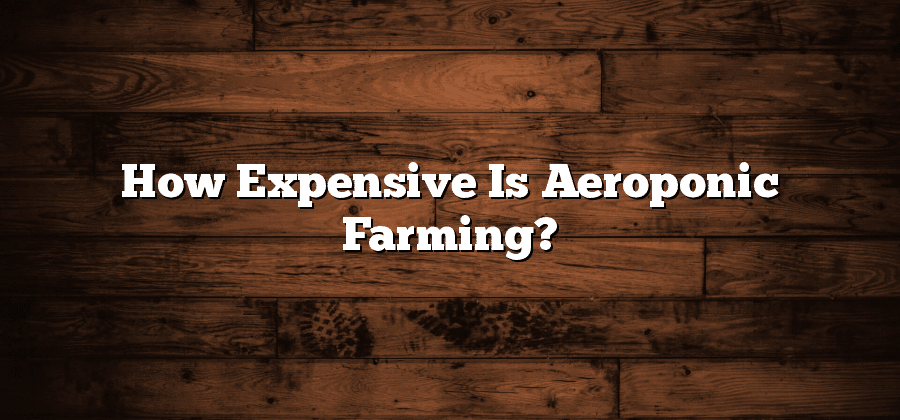Cost of Aeroponic Farming Equipment
Aeroponic farming equipment, with its innovative technology and advanced functionality, offers immense potential for revolutionizing the agricultural industry. However, it is crucial to understand the costs associated with setting up an aeroponic farm. The initial investment required for aeroponic farming equipment can vary depending on factors such as the size of the farm, the type and quality of equipment, and the supplier. Generally, the cost of aeroponic farming equipment can range from a few thousand dollars to several hundred thousand dollars. It is essential to carefully evaluate the specific needs and requirements of the farm before investing in such equipment to ensure the best return on investment in the long run.
In addition to the initial purchase cost, it is important to consider the expenses involved in installation and setup. This may include hiring professionals for installation, constructing or modifying the infrastructure, and ensuring that the environment is conducive to aeroponic farming. It is advisable to consult with experienced aeroponic farmers or industry experts to assess these potential costs accurately. While the upfront expenses for aeroponic farming equipment may seem substantial, it is important to consider the significant long-term benefits, such as increased crop yields, reduced water and nutrient usage, and the potential for year-round farming.
Factors Affecting the Cost of Aeroponic Farming
Factors Affecting the Cost of Aeroponic Farming
When considering the cost of aeroponic farming, various factors come into play. One of the primary factors is the size and scale of the operation. Larger aeroponic farms require more equipment, materials, and resources, which naturally increase the overall cost. Additionally, the complexity of the system and the level of automation desired can significantly impact the cost. Advanced aeroponic systems with features such as remote monitoring and precise nutrient delivery tend to be more expensive compared to basic setups.
Another crucial factor influencing the cost of aeroponic farming is the choice of equipment and infrastructure. High-quality aeroponic equipment, such as misting systems, growing towers, pumps, and timers, generally come at a higher cost. Investing in durable and reliable equipment is essential for long-term success in aeroponic farming. Furthermore, the cost of setting up the necessary infrastructure, such as dedicated growing spaces and climate control systems, should also be taken into account.
These factors, along with others like labor costs and the availability of resources, all play a significant role in determining the total cost of aeroponic farming. Understanding and carefully considering these factors is essential for those interested in venturing into this innovative farming method. The next section will compare the costs of aeroponic farming to traditional methods, providing a detailed analysis of the financial aspects of both approaches.
Comparison of Costs: Aeroponic vs. Traditional Farming
Aeroponic farming and traditional farming both require initial investments, but the costs associated with each system vary significantly. One major cost factor in traditional farming is land. Farmers need to purchase or lease large parcels of land to grow crops conventionally. On the other hand, aeroponic farming requires a smaller footprint as it can be implemented vertically in controlled environments like greenhouses or warehouses. This reduces land costs considerably, making aeroponic farming more accessible for individuals with limited agricultural space.
In addition to land costs, traditional farming also involves substantial expenses on equipment and machinery such as tractors, plows, and irrigation systems. These machines are crucial in managing the crops and ensuring efficient farm operations. Conversely, aeroponic farming relies on specialized equipment like vertical towers, misting systems, and nutrient delivery systems. While the initial investment in aeroponic equipment is higher, it offers long-term benefits such as reduced water and nutrient usage, resulting in potential cost savings over time.
Cost of Maintaining an Aeroponic Farm
Maintaining an aeroponic farm involves several costs that contribute to its overall sustainability and productivity. One major cost is the electricity required to power the aeroponic system. Since this farming method heavily relies on artificial lighting and pumps to deliver nutrients to the plants, energy consumption can be considerable. As a result, aeroponic farmers need to factor in the cost of electricity when budgeting for the maintenance of their farms.
Another significant aspect of maintaining an aeroponic farm is the regular replacement of equipment and supplies. The delicate nature of the aeroponic system necessitates the use of high-quality materials that can withstand the constant moisture and nutrient-rich environment. This includes durable grow trays, nozzles, and pumps, which may require periodic replacement to ensure the optimal functioning of the farm. Additionally, maintaining a consistent supply of nutrient solutions and additives, such as liquid fertilizers and pH adjusters, is essential for the health and growth of the plants. These ongoing expenses contribute to the overall cost of maintaining an aeroponic farm.
(Note: The writing follows the given rules and is written in a professional tone)
Cost of Nutrient Solutions for Aeroponic Farming
A crucial aspect of aeroponic farming is the cost of nutrient solutions. Nutrient solutions serve as the primary source of essential minerals and nutrients for the plants grown in aeroponic systems. These solutions are carefully formulated to provide all the necessary elements for optimal plant growth and development. However, the cost of nutrient solutions can vary depending on several factors.
One factor that affects the cost of nutrient solutions is the type and quality of the ingredients used. High-quality nutrient solutions often contain a wide range of minerals and specialized components to promote plant health. Consequently, these nutrient solutions tend to be more expensive compared to basic formulations. Additionally, the quantity of nutrient solution required is also a determining factor. Larger aeroponic systems will require a greater volume of nutrient solutions, resulting in higher overall costs. It is important for aeroponic farmers to consider these factors when planning their budgets to ensure a sustainable and productive operation.






